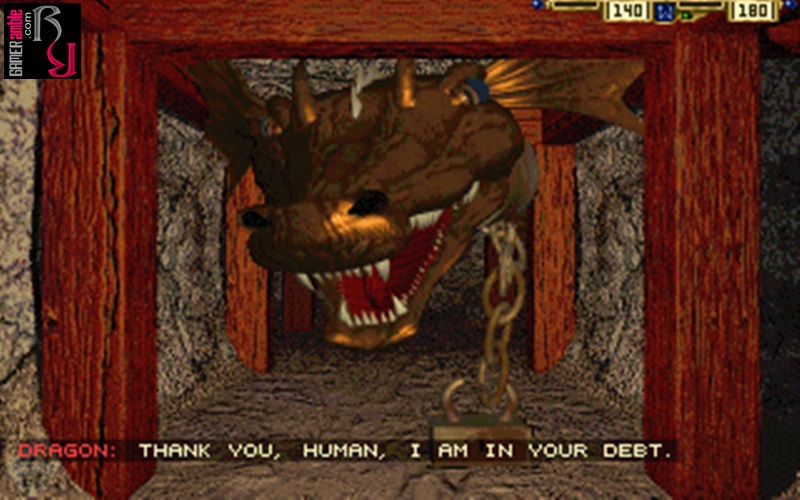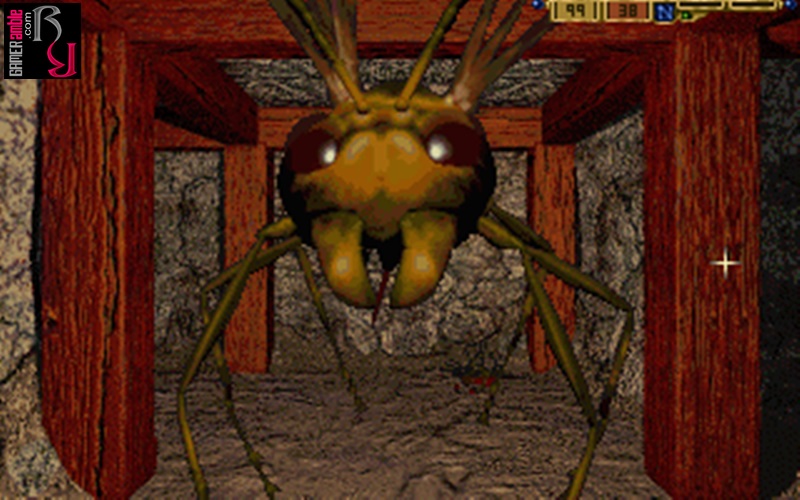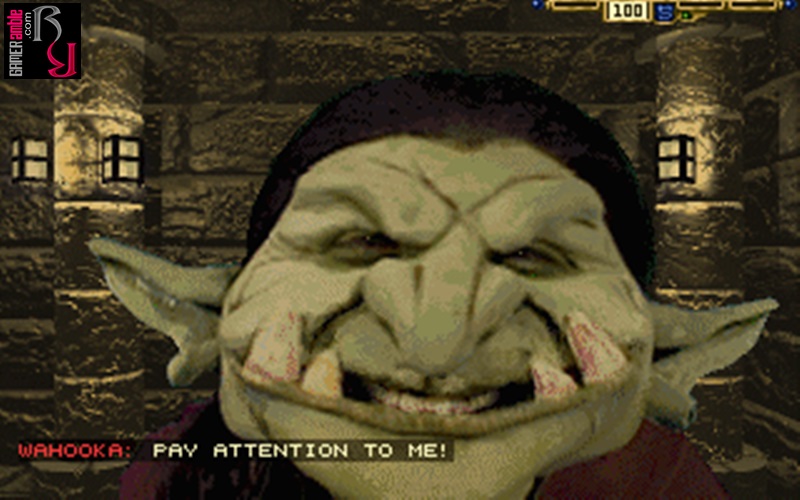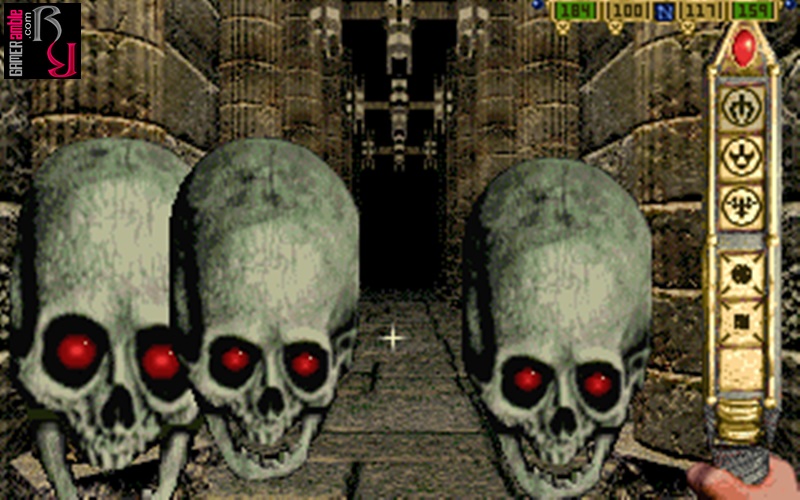Stonekeep
Developer: Interplay Entertainment | Publisher: Interplay Entertainment | Release Date: 1995 | Genre: RPG / Dungeon Crawler | Website: N/A | Purchase: GOG
The wait is finally over and after something like a five year wait, Stonekeep has finally arrived. So, as one of the most hyped and eagerly anticipated First Person Role Playing games in a long time, does Stonekeep live up to it’s expectations? First the storyline. You play the role of Drake, who at the age of ten had to witness how his entire village was wiped out by some evil god called the Shadowlord. Only Drake survived, saved by a mysterious creature who whisked him to safety at the last moment. Now some years later Drake is back and ready to take on the underground labyrinth of Stonekeep for revenge and answers. Freed from his body by the goddess Thera, Drake must now find the nine orbs holding the other gods trapped by the Shadowlord, Khull Khuumm. Your quest won’t be easy, but along the way you’ll find many answers and quite a few trusty companions.
Graphically Stonekeep is superb. The whole game is played in a full screen first person perspective where you move around in step movement. Interplay has streamlined everything so there are no icons or obtrusive menus blocking your view. The only thing you’ll see is a tiny compass and some energy bars which can be turned off. This is not recommended though as combat is in real time, so knowing the state of your health at all times is vital. You won’t have to fight alone though, as up to three other characters can join your party. However, you have no direct control over them, so you can focus on your own combat while they provide some much needed support.
Stonekeep is unique because of it’s mix of FMV characters and 3D rendered creatures. Almost everyone you meet is a actor that has been digitized into the game with full make-up and costume. While some of them can look quite corny the overall effect is quite nice and provide some entertaining encounters. Enemies on the other hand can also either be an actor in costume or a fierce creature that has been rendered in 3D. These look brilliant and can really get in your face while fighting. The impressive thing is unlike other games where enemies get pixilated when they get closer, these monster actually become more detailed. (Obviously looking at the game now everything looks pixilated, but back in 1995 the visuals were impressive! -ED.) The environments are all silicon graphics and feature a few rendered effects to bring them to life. While the dungeons are impressive enough the endless corridors all look the same and after a while the effect is diminished somewhat.
The multitude of encounters and secrets keeps things fresh though. Walking around you might hear a faint breeze that alerts you to a secret passage or spot a faint button on a wall that can be pushed to reveal a hidden room. While there aren’t that many puzzles in the game there are a few devious ones that will keep you guessing for a while. There are also quite a few tricks and traps so be on your toes. While playing Stonekeep I was lured into a room by the treasure chest that stood against the far wall. Instead of the goodies I was expecting this only resulted in me falling down a pit concealed in the doorway. Once down, the camera panned upwards to a ugly creature pushing a boulder down into the room, giving me split seconds to get out of the way before I was crushed. Not every creature you encounter wants to end your life though. Some creatures actually leave you alone if you don’t attack them, so don’t go around assaulting everything that moves. Creatures that attack you on the earlier levels might even have family on the lower levels that are a bit more civilized and might even join your party. Of course, Drake isn’t above trading the occasional insult with the many enemies you encounter either, and these scenes can be quite funny. One of my favorite is a group of enemies that jump out and try to mug you. Their leader leaps forward shouting “let’s get him boys” before stopping and asking “’er boys?”.
The interface of the game has been completely streamlined ensuring that you focus on playing the game and not struggle with the controls. Mapping is handled automatically and you have a journal which holds all your notes, inventory descriptions, magic runes and other bits and pieces. You also have a magic scroll that serves as an inventory that can hold unlimited items. Every item you put in it turns into a small graphical representation meaning you don’t ever have to worry about running out of space or becoming encumbered. This also means you can lug around a load of useless stuff and by the end of the game I had countless swords, rocks and skulls. The auto-map is handy and can be brought up by a quick press of the TAB key. You can also add your own notes and markers to these maps, which is useful to single out places of interest.
On your travels you can find loads of items and weapons and one of the cool aspects of the game is the fact that enemies drop their weapons when they die. In other games you usually get attacked by a large demon with a seemingly magical sword only to find it has disappeared when you kill the damn thing. Not so here. If you get attacked by something wielding an axe or sword you can be sure that it will be there when you kill it. Of course, this means you can also end up with loads of surplus weapons. You can also expect to be pelted by rocks and other projectiles as enemies love hurling stuff at you. Don’t worry though as you can return the favor with rocks, arrows, bolts and other missiles.
Unlike similar games you never increase your character levels or gain experience in the normal sense. Instead you have an array of stats like strength, agility and health as well as a few for weapons like axe, brawl, dagger, magic, stealth etc. Using a certain weapon or casting a certain spell a lot will cause the stats of that skill to increase, improving your ability with it. That means if your stealth is high you’ll get the drop on enemies more or if you use a bow a lot you’ll find that your accuracy increases. This system works fairly well, but I still missed the new skills or magic spells that usually accompanies a level increase in standard role playing games.
Stonekeep also has a unique magic system where you cast spells via runes that you find and then carve onto a special staff called a runecaster. You have no mana and each staff can only hold a certain amount of charges so be careful what spells you carve on it. Runes can be changed or erased at any time and as long as you have a rune scribed in your journal you can use the spell. You can find more and better staves and there are some recharge points, but it still a good idea not to waste spells.
One of the best parts of the game is the audio. Everything in the game is full speech and some of the conversations (especially the faeries ) are hilarious. Stonekeep has quite a wicked sense of humor and more than once I found myself laughing out loud. Music in the game is quite atmospheric and there are some really nice tunes to keep you company in your travels through the dark tunnels of Stonekeep. While the music is kind of low key the sound effects on the other hand are crystal clear and awesome. Every noise and footstep are in full stereo and this is one of those games where you’ll want to crank the volume to really get into the mood of the game. Sounds can also help you to determine from what direction a trap or fireball is coming or where that elusive enemy stalking you is.
Even with a budget of over $5 million Stonekeep is not perfect. The first annoying thing is that you have no sidestep button. This can be really awkward in combat, especially for players used to this feature which is found in virtually every other first person RPG. You can also only move with the keyboard ( the left and right mouse buttons act as your left and right hands ) but since this is the preferred method for most players this isn’t much of a problem. While combat can be slightly tedious at times the enemies do stay dead when killed and doesn’t respawn to cause you more grief. Of course in some cases you have to make sure they don’t come back, like carrying away the skulls of skeletons as souvenirs to make sure they don’t head your way again. You also have very little control over your party structure with characters joining and leaving at predetermined points. All dialogue is also handled automatically and you just sit back and listen without any dialogue trees or interaction. A few bugs also crop up from time to time, but nothing really serious and overall the game was pretty solid.
Despite all it’s minor flaws Stonekeep is a awesome game that will keep you playing for many hours. It’s clear to see that Interplay has spend a lot of time and effort on this title and the have delivered on their promise of a game for gamers by gamers. The game has a cool storyline, great characters and packs quite a challenge. When you get into this one you’ll definitely want to stick with it right to the end and you can be sure that there will be quite a few Stonekeep imitators popping up soon. It’s definitely not the “ultimate” RPG but it contains enough innovations and surprises to make it a definite classic. Don’t miss out on this one.
*Review originally published in 1995.
System Requirements
- OS: Windows XP or Windows Vista
- Processor: 1 GHz Processor (1.4 GHz recommended)
- Memory: 512MB RAM (1 GB recommended)
- Graphics: 3D graphics card compatible with DirectX 7 (compatible with DirectX 9 recommended)
- DirectX: Version 9.0
- Hard Drive: 376.5 MB
- OS: OS X 10.6.8 or later.
- Processor: Intel Core Duo 2GHz+
- Memory: 1GB of RAM
- Graphics: 64MB of video memory
- Hard Drive: 376.5 MB
- Additional Notes: Recommended two-button mouse, or Apple mouse with Secondary Button / Secondary Click enabled.
















